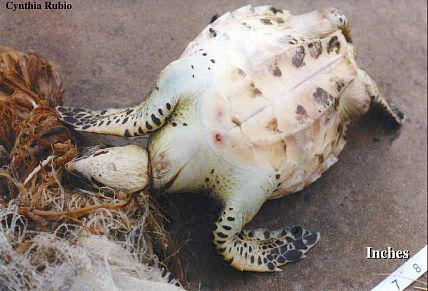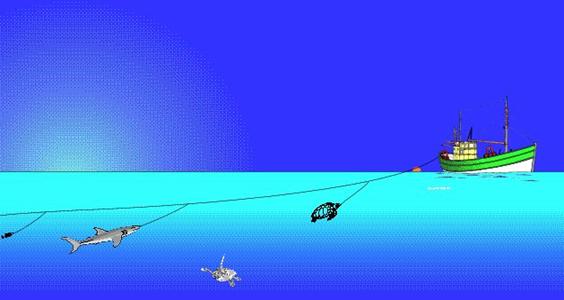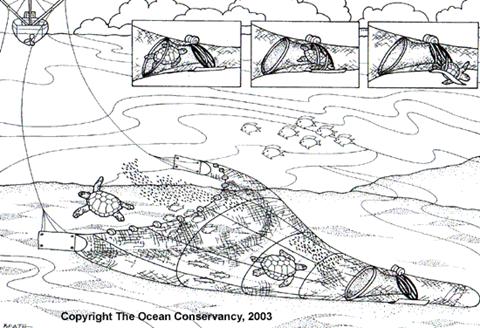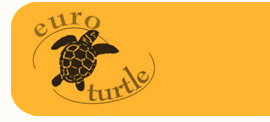
Hawksbill sea turtle strangled in line and netting.
Photo: Sea Turtle Stranding and Salvage Network
The
main types of fishing methods used are:
• Long-line fishing
• Trawl net fishing
• Drift-net or Gill-net fishing
• Shrimp Fisheries
Sea turtles are migratory and travel thousands of kilometres each
year to nest. In 2000, 1.4 billion hooks were cast into the world’s
oceans through industrial fishing- snagging more than 200,000 loggerhead
sea turtles resulting in the deaths of thousands of them. The threat
of fisheries is very serious to the long-term survival of the sea
turtle population and to address such issues requires an international
solution (Source: www.surfbirds.com).
There are three main types of fishing technique employed by the
Mediterranean fishing industries which cause the incidental capture
of sea turtles. They are long-line fishing, trawl-net fishing and
drift-net or gill-net fishing.
Long-line
fishing Fast Fact:
A recent study in the scientific journal Ecology Letters estimates
that worldwide about 200,000 loggerheads and 50,000 leatherbacks
are caught every two years by longlines. Scientists have warned
that the Pacific leatherback could go extinct within the next
5-30 years unless immediate action is taken to reverse their
slide into oblivion. One of those actions is to impose a Pacific
wide moratorium on longline fishing.
|
Long-line
fishing:
In long-line fishing each fishing unit consists of a floating 'mother-line',
300m long, from which hang the hooked 'groundlines', each 25m long,
at 20m intervals. Units can be strung together in great chains.
It is not unusual for 200 units to be strung together to reach a
length of 60Km. This method of fishing is usually used to catch
Swordfish and Albacore in the Mediterranean.

Long-line
fishing
Trawl
net fishing is where a boat drags behind it an enclosed net. The
net forms a sock shaped enclosure catching any matter that enters
it. The mesh of the trawl net tends to be very small as this type
of fishing is primarily used for shrimping. The picture below shows
the apparatus used for trawl net fishing.

Trawl
net fishing
Drift-net
or Gill-net fishing Fast Fact
Known as "curtains of death" because they catch
and kill everything in their path, large gillnets (also known
as driftnets) were banned by the United Nations on the high
seas in 1991. Along with sea turtles, gillnets also injure
or kill sperm whales, humpback whales, fin whales, Steller
sea lions and other threatened and endangered species. In
fact, according to observer data obtained from NOAA Fisheries,
64 dolphins, whales, seals and sea lions have been killed
by the gillnet fishery since 2002. (Source: www.surfbirds.com)
|
Drift-net
or Gill-net fishing involves the use of huge net. The net
is essentially an area of mesh; it is not fixed into any assembly..
The mesh of the net is just large enough to allow the heads of the
fish to pass through while trapping them at their gills. The net
is usually dragged behind a single boat in a loop or may be fastened
to two boats on a parallel course. This type of fishing is usually
used to catch Tuna, Swordfish and Albacore. Below is a diagram explaining
how a drift-net is used.

Drift net/ Gill-net fishing
Shrimp
Fisheries
|
The highest level of all turtle mortality world-wide is associated
with the shrimp trawling industry, which it is calculated kills
ten times as many turtles as all other forms of fishing put together
(National Research Council 1990). As well as causing the turtles
to drown by trapping them in nets underwater for hours, there have
recently been reports in the Mediterranean that pollution caused
by shrimp farms kills turtles.
|
|





